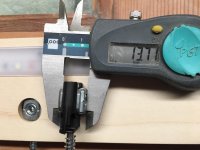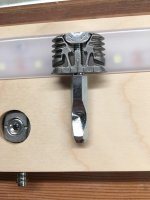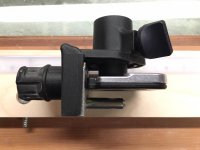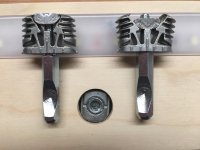You are using an out of date browser. It may not display this or other websites correctly.
You should upgrade or use an alternative browser.
You should upgrade or use an alternative browser.
Df500 connection system 16mm board
- Thread starter EugeneRSA
- Start date
Cheese
Member
EugeneRSA said:Most of my market prefer 16mm boards.
[member=71093]EugeneRSA[/member]
While the D8 System was designed for 18 mm material, the system should work on approximately 16-22 mm material. Here's a photo of a D8 in 18 mm BB. You can see that it's recessed about 2 mm below the surface. Also note that the thickness of the D8 assembly is 13.7 mm.
Further, the drill template/jig, BS-KV D15, is also adjustable for varying material thicknesses.
If you decide to go this way, please check back and let us know if there are any pitfalls. [smile]
[attachimg=1]
Attachments
Michael Kellough
Member
[member=44099]Cheese[/member] does the fitting expand in thickness when tightened, or only in width?
Cheese
Member
Michael Kellough said:[member=44099]Cheese[/member] does the fitting expand in thickness when tightened, or only in width?
Only in width Michael.
[attachimg=1]
I certainly don't know this for a fact but I'd bet the fitting may work in 14 mm material for very light duty applications.
The drill jig is adjustable from 4 mm to 20 mm.
[attachimg=2]
Attachments
Cheese
Member
Hey [member=297]Michael Kellough[/member] I was dinging around today with the D8 connectors and took some measurements that may be of some interest to you.
[attachimg=1]
Bottom width normal = 20.9 mm
Bottom width expanded = 21.3 mm
Top width normal = 20.6 mm
Top width expanded = 23.6 mm
[attachimg=1]
Bottom width normal = 20.9 mm
Bottom width expanded = 21.3 mm
Top width normal = 20.6 mm
Top width expanded = 23.6 mm
Attachments
Michael Kellough
Member
[member=44099]Cheese[/member] Thanks for the info. Don’t know much about these fittings yet.
Do you set (expand) the fitting by tightening the hex stud prior to joining with the other piece of wood or do you just tighten the screw?
Looks like tightening the screw would tug the hex stud as the screw tries to get to the bottom of the depression in the stud but that seems a pretty indirect and weak way to set the fitting’s wings.
Do you set (expand) the fitting by tightening the hex stud prior to joining with the other piece of wood or do you just tighten the screw?
Looks like tightening the screw would tug the hex stud as the screw tries to get to the bottom of the depression in the stud but that seems a pretty indirect and weak way to set the fitting’s wings.
cpw
Member
You have to domino out the mortise, then drill. After drilling you can set the fitting into the mortise. I've found that you should make sure to give it an extra tap; otherwise it can pull out a bit proud the surface. At that point, you can put the hex stud in that receives the set screw, and it pulls on the keystone-like anchor spreading the wings. They are in very solidly at that point, and will not come out without damaging the surrounding wood.Michael Kellough said:[member=44099]Cheese[/member] Thanks for the info. Don’t know much about these fittings yet.
Do you set (expand) the fitting by tightening the hex stud prior to joining with the other piece of wood or do you just tighten the screw?
Looks like tightening the screw would tug the hex stud as the screw tries to get to the bottom of the depression in the stud but that seems a pretty indirect and weak way to set the fitting’s wings.
I've found it a bit annoying that you can not safely remove the hex stud, because the keystone might get lost in the mortise and you'll not be able to put it back. It would be much nicer if there was something in back that would retain it in an approximate position; so that you could assemble then knock things down without having the hardware sticking out.
Michael Kellough
Member
[member=63643]cpw[/member] “I've found it a bit annoying that you can not safely remove the hex stud, because the keystone might get lost in the mortise and you'll not be able to put it back. It would be much nicer if there was something in back that would retain it in an approximate position; so that you could assemble then knock things down without having the hardware sticking out.”
Shove a scrap of polyurethane foam in the mortise first?
Shove a scrap of polyurethane foam in the mortise first?
cpw
Member
That might work, and you don't always lose the keystone, but I did had to one with needle nose pliers at one point and it wasn't fun. It just seems for $2.20 a piece they could have a made it more reusable without needing extra steps.Michael Kellough said:[member=63643]cpw[/member] “I've found it a bit annoying that you can not safely remove the hex stud, because the keystone might get lost in the mortise and you'll not be able to put it back. It would be much nicer if there was something in back that would retain it in an approximate position; so that you could assemble then knock things down without having the hardware sticking out.”
Shove a scrap of polyurethane foam in the mortise first?
I've built a few things with them and am very happy with how well they hold, the ease/speed of installation, and the finished look. The ability to lose that keystone is the only gripe I have with them.
Cheese
Member
Michael Kellough said:Do you set (expand) the fitting by tightening the hex stud prior to joining with the other piece of wood or do you just tighten the screw?
Looks like tightening the screw would tug the hex stud as the screw tries to get to the bottom of the depression in the stud but that seems a pretty indirect and weak way to set the fitting’s wings.
[member=297]Michael Kellough[/member] I'm not using the expandable connectors in this application. I'm using the KV-LR32 connector to attach face frames that may need to be removed for access in the future.
[attachimg=1]
Attachments
Similar threads
- Replies
- 37
- Views
- 360K
- Replies
- 30
- Views
- 5K
- Replies
- 17
- Views
- 15K
- Replies
- 5
- Views
- 745





